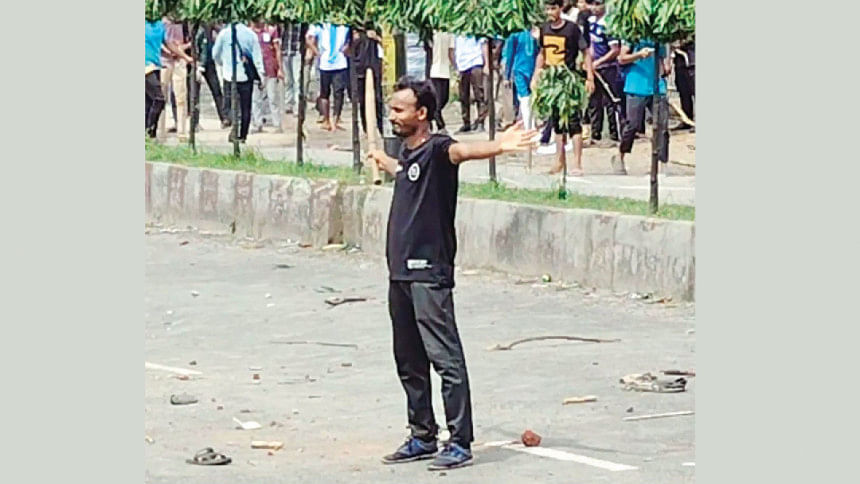Abu Sayed’s autopsy report altered 6 times
The world saw how Abu Sayed was shot by policemen from across the street. His outstretched arms brandishing a tree branch in one, his chest pushed out in defiance, the young Rangpur undergrad had dared the police to shoot. And shoot they did.
Soon afterwards, he collapsed on the street and then was carried away by other protesters. For the millions who watched the clip, it was clearly evident how he died on July 16, 2024. Sayed became an icon of resistance in the uprising almost overnight.
An assistant professor of forensic medicine at the Rangpur Medical College, Dr Rajibul Islam, had clearly stated in his initial report that Sayed had died from shotgun pellet wounds. The doctor was forced to change his findings six times as external forces closed in.
He had to mention external head injuries, other wounds, and blood clots in various parts of Sayed’s body. His final “conclusion” for the cause of death was shock and haemorrhage resulting from these injuries.
The case is currently being investigated by the International Crimes Tribunal (ICT). Investigators say the doctor has named four people closely linked with the deposed Awami League regime who forced his hand. They include two former deputy commissioners of Rangpur Metropolitan Police, a senior official of Rangpur Medical College, and a leader of the pro-Awami League doctors’ platform Swadhinata Chikitsak Parishad (Swachip). Investigators say that the four people involved in manipulating the post-mortem report may face arrest and trial.
Sayed’s defiance and martyrdom inflamed students across the country and galvanised the protests, as people began to join in ever larger numbers. His sacrifice was one of the turning points in the anti-discrimination student movement that culminated into a people’s uprising and went on to topple Sheikh Hasina’s autocratic regime on August 5. His supreme sacrifice became a symbol as well as the spirit of the movement that rallied protesters and inspired them to challenge the regime.
The police had tried to manipulate the case even before it reached the pathologist’s table at the Rangpur Medical College. According to the first information report (FIR) at the Tajhat Police Station, Sayed was not a victim of police firing. The police report accused 2,000–3,000 unidentified individuals, including BNP and Jamaat-Shibir protesters, of the murder. The police claimed that these protesters had fired weapons and showered brickbats, killing “an individual”. The FIR stated that the police only found out later that it was one Abu Sayed, an undergrad at Begum Rokeya University. Sayed’s classmates took him to Rangpur Medical College Hospital, where doctors pronounced him dead, the report added. In an attempt to further deflect the investigation, the police even went so far as to accuse a 16-year-old 11th-grader in the case, who had himself been injured during the protests.
Abu Maruf Hossain, then a deputy commissioner of Rangpur Metropolitan Police, was the first to request Rajibul to review his autopsy report. The police officer had marked the report with a cross and asked the doctor to burn it and write another one. Rajibul complied. But Maruf was not happy. He crossed it out and asked for another review. This time, he ordered the doctor to tear up the report and write another one, according to the doctor’s statement given to the ICT investigators.
Rajibul did not respond to a phone call for comment, but he had earlier told The Daily Star that he was under immense pressure to falsify the autopsy report. He claimed he was coerced into modifying the report six times.
Maruf did not receive a call either.
“They ordered me to conclude that Sayed died from a head injury,” said the doctor. Sayed had sustained the head injury earlier in the day during a clash with Chhatra League men.
This newspaper has obtained two copies of Sayed’s autopsy report, both signed by Rajibul. One version explicitly states, “The cause of death was due to shock and haemorrhage as a result of firearm injuries (shotgun), which were antemortem and homicidal in nature.”
Another version, which was ultimately submitted on July 30, mentioned external head injuries, marks of wounds, and blood clots in different parts of Sayed’s body. “The cause of death was due to shock and haemorrhage as a result of above-mentioned injuries which is antemortem and homicidal in nature.”
Investigators found a copy of the original report discarded in an abandoned location, with a cross mark on it.
A 12-member investigation team led by two ICT prosecutors recently interrogated Rajibul, who disclosed the names of those involved in the cover-up attempt. The investigators gathered digital evidence, tracking the movements of those who entered the office where the post-mortem report was tampered with.
On January 13, Sayed’s elder brother Ramzan Ali lodged a complaint with the ICT’s prosecution wing against Hasina and 23 others, accusing them of orchestrating Sayed’s murder.
Ramzan had earlier filed a murder case with Tajhat Police Station in Rangpur on August 18 against 17 named individuals. They included Chowdhury Abdullah Al Mamun, former inspector general of police; Abdul Baten, former deputy inspector general of police at Rangpur Range; and Md Moniruzzaman, former commissioner of Rangpur Metropolitan Police. Some 130–135 unidentified others were also made accused.
LondonGBDESK//



Comments are closed.